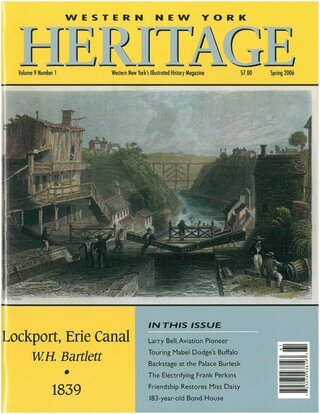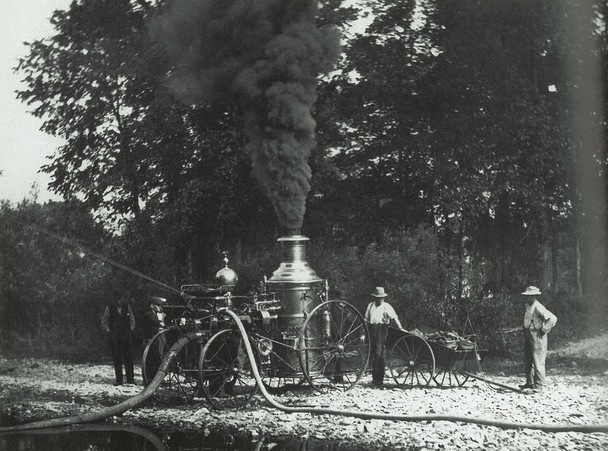
The acceptance test of the Friendship Fire Department’s new Silsby Steam Fire Engine, c. 1882. The steamer pumped water from Van Campen Creek through 1,000 feet of hose and sent a stream of water 180 feet over the steeple of the Baptist church. The spraying feat will be re-created on July 29, 2006 at the unveiling of the Silsby’s restoration.
Courtesy Town of Friendship
On March 7, 1881 the residents of the town of Friendship in Allegany County fought a major fire that destroyed 13 buildings along its main street. A quickly formed bucket brigade was unable to control the blaze because the town did not have a fire department.
As a result of the devasting fire, the businessmen in the town of 1,900 residents made a decision to form a fire department and purchase a Silsby Steam Fire Engine.
Manufactured by the Silsby Manufacturing Company of Seneca Falls, NY, it was a fifth-size village engine that could pump 500 gallons per minute through its two discharge outlets and cost $3,500. When the steamer was being made at the factory, the workers christened it Miss Daisy. The name lives today, 125 years later, as does the engine in a unique, community-wide restoration that has gained national attention.
Steaming Through History
When the steamer was purchased, the community did not have a water system with hydrants. A decision was made to build seven cisterns throughout the town. They were used to supply the steamer with water to fight fires.
The 98-year-old Merrill Case, who engineered Miss Daisy in the early days, recalled that the engine was so steady when doing its heaviest duty, he could put a quarter on the wheels and it would not fall off. He added that the boiler could generate a full head of steam in less than five minutes, allowing it to pump water as soon as it arrived at the fire.
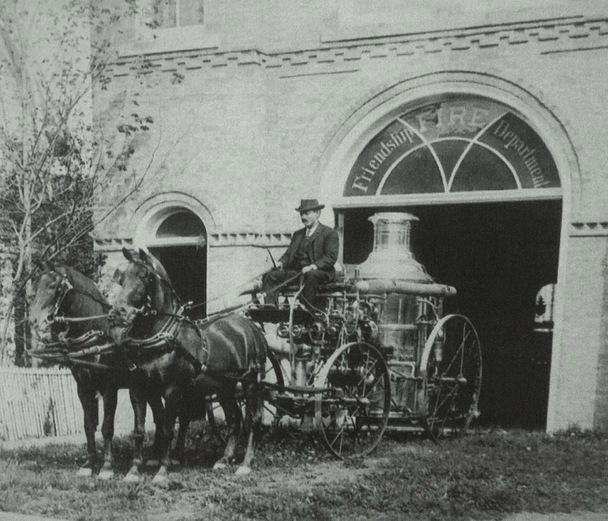
The Silsby rolling out of Friendship Fire Hall early in the century. It was retired there in 1932.
Courtesy Town of Friendship
Part of this fast steam response was the use of a Silsby water heater in the fire hall. The heater was a small coal-fired boiler which was connected to Miss Daisy. It continually circulated hot water through the boiler of the pumper and kept its temperature just below steam pressure. When an alarm sounded, the boiler heater was automatically disconnected from the steamer as it pulled out of the fire hall. Without the boiler heater, it would require up to an hour to an hour-and-a-half to turn the boilers’ water to steam. It is believed that the Friendship boiler heater is the only unit of its type in existence in the country.
At the end of the 19th century, a knowledgeable steam fire engine expert, William T. King, described in his book, The History of the American Steam Fire Engine, the unparalleled record of the Silsby steam fire engine, especially when compared to the piston engines of the era. King pointed out that the engine’s steam turbine and rotary pump, invented by Birdsill Holly of Lockport, eliminated pump valves and reduced friction because there were no head slides or link blocks, as on piston engines.
King considered the Silsby the best fire pump in the world. He pointed out that over 1,000 Silsby engines had been built and sold. The self-priming pump could draught water up to 29 feet and pump it through 3,000 feet of hose.
Miss Daisy saw 50 years of duty before it was taken out of service in 1932 when a motorized Buffalo Fire Appliance engine was purchased. The steamer was stored in the Friendship Fire Hall for the next 73 years before it began its second life.
Silsby Restoration Project
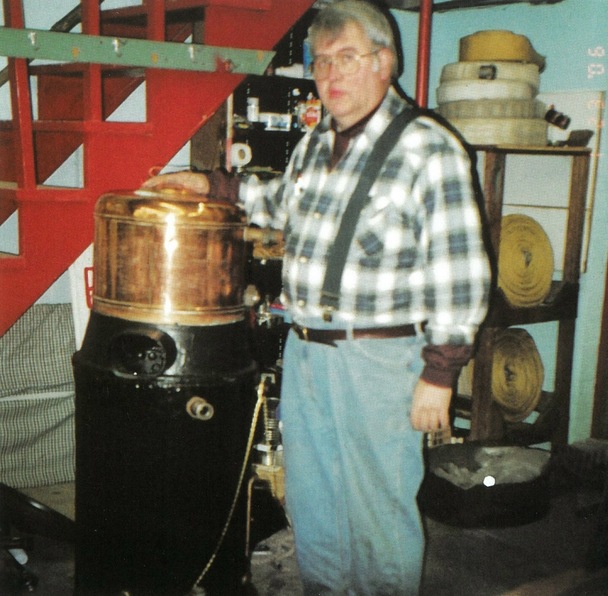
Tom Cannon, who spearheaded the restoration drive, stands next to the restored Silsby boiler heater. It was rebuilt by several Friendship school students working at BOCES.
Author’s Photo
Tom Cannon saw the steamer in its retirement home and realized that it could be rebuilt and made operational again. He discussed the project with Friendship Fire Chief Wesley Sotore and the fire company solidly got behind the project. Realizing the renovation would be expensive, they decided to get everyone in the community involved in fundraising.
The project included people of all ages. The Silsby Restoration Project was divided into three parts. A community education program for youth of all ages centered on a children’s story called, “Daisy Comes to Town.” It describes the formation of a small-town fire department from a second graders’ perspective. The second part was the raising of the $25,000-30,000 needed to rehabilitate and make Miss Daisy operational. The third part was to re-enact the pumping of water over the steeple of the old Baptist Church, the tallest in town. (When the engine was originally purchased, one of the provisions of the contract was that the engine had to be able to pump water over the Baptist Church steeple, which it accomplished.)
With the help of New York State Senator Cathy Young, Cannon and the fire company applied to The History Channel’s Save Our History program which recognizes local communities and classrooms that demonstrate outstanding commitment to history education and preservation of local history.
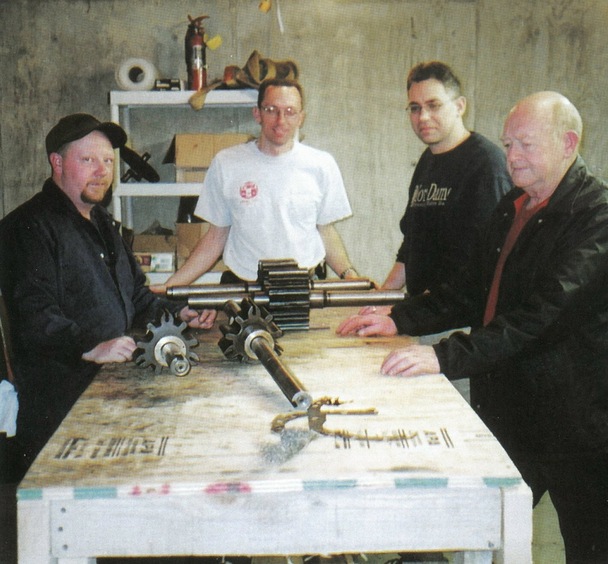
Members of the Friendship Fire Department inspecting the parts of the Silsby Fire Engine pump and steam turbine. From left, Dennis Burnell, Fire Chief Wes Sotore, Tom Talbert, Jr. and Matt Tuttle.
Author's Photo
On May 24, 2005 in Washington D.C., the Friendship Fire Company was awarded the grand prize in the Civic History Preservation category. An award of $10,000 was presented with the award citation reading:
The Silsby Restoration Project was undertaken by the Friendship Fire Department to preserve the community’s first pieces of firefighting equipment. These are not only 125 years old, but also the only original pieces of firefighting equipment passed down like this in the entire state of New York.
This project had elements of fundraising, restoration, research, photography, and lectures and united firefighters with students from Friendship Central School, government officials and local historians.
Coming Out Party
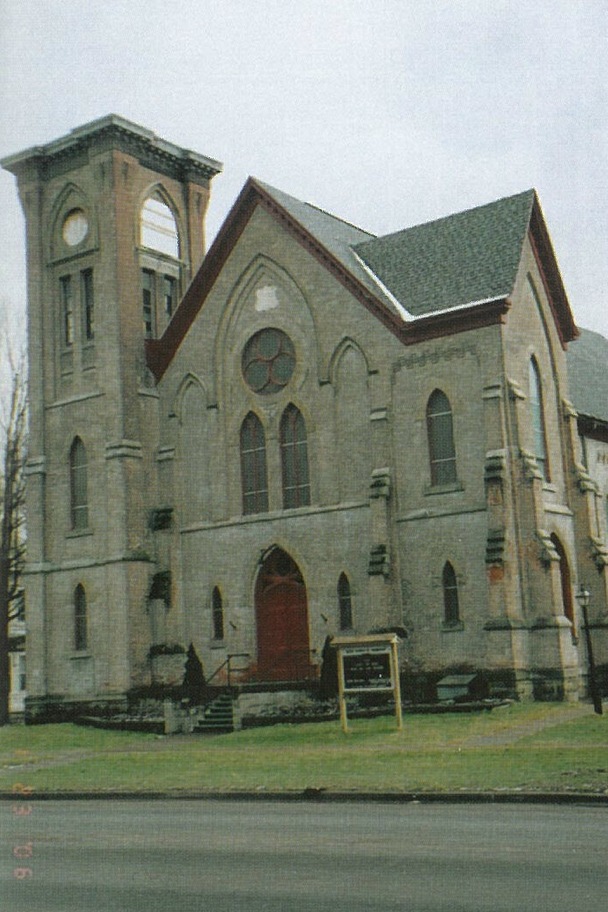
The Friendship Baptist Church, over which the Silsby will spray water at its restoration celebration. The original steeple was destroyed in the 1920s by a tornado that swept through Friendship.
Author's Photo
The culmination of the Silsby Restoration Project will be Miss Daisy’s Coming Out Party on Saturday, July 29, 2006. Miss Daisy will be feted with a parade of hand-pulled, horse-drawn and motorized antique fire protection equipment.
The highlight of the day’s activities will be the re-enactment of the pumping of water over the steeple of the tallest church in town, just as Miss Daisy did 125 years ago.
The occasion will be a tribute to the determined efforts of a town aptly called Friendship.




